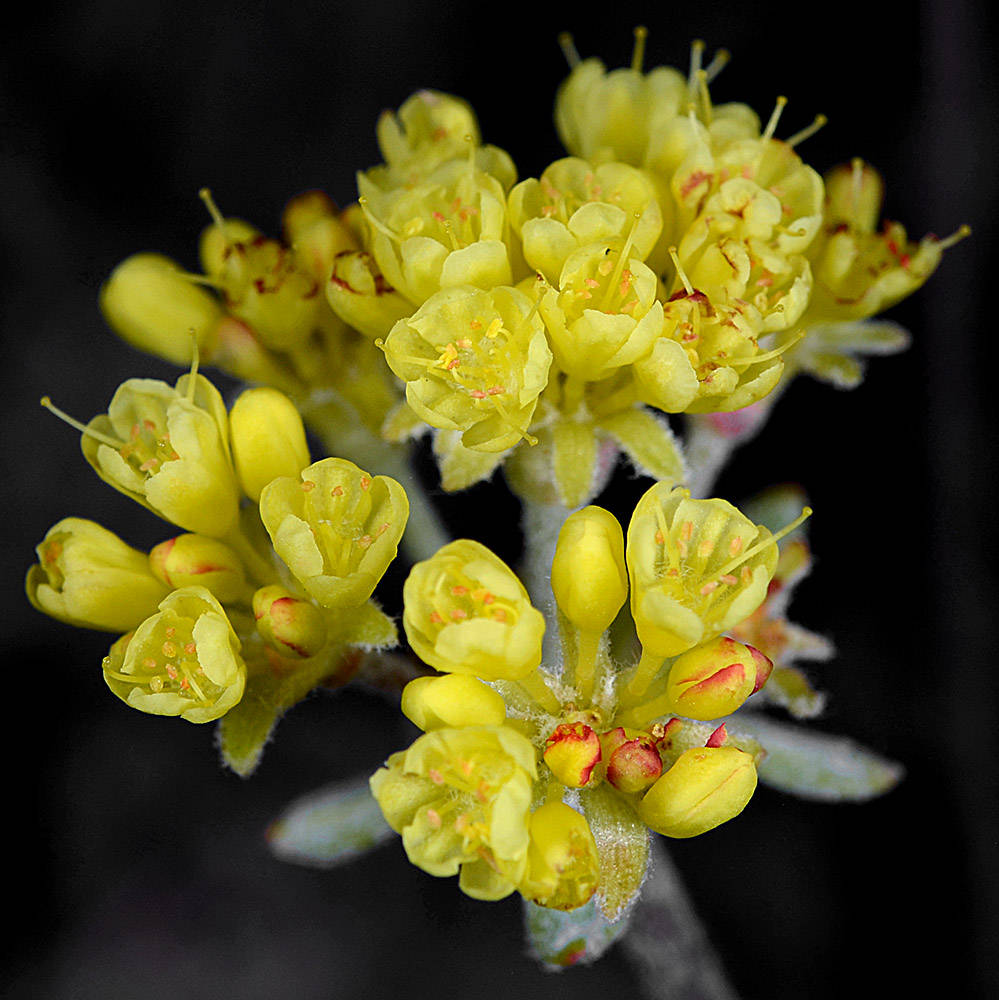
[This taxon will be assessed for treatment in volume 3 of Flora of Oregon, which is not yet published.]
Sulfur-flower buckwheat is an extremely variable low, mounding, shrub species, with 13 varieties recognized in Oregon alone. The flowers can be cream to yellow or pink, but are always in compact clusters held above the low cushion of gray to green leaves. This buckwheat will appreciate an open, rocky, well-drained site. You will be rewarded with wildlife visitors for flower nectar and seeds and you may also find butterfly caterpillars as it is a host for several species.Sulfur-flower buckwheat is an extremely variable,with 13 varieties recognized in Oregon alone. A low, mounding, shrub species, its flowers can range from sulfur yellow to creamy pink but are always in compact clusters held above a low cushion of gray to green leaves. This buckwheat will appreciate an open, rocky, well-drained site. You will be rewarded with wildlife visitors for nectar and seeds. Look closely and you may also find butterfly caterpillars, as it is a host for several species.
as described under Eriogonum umbellatum
Herbs, subshrubs, or shrubs, cespitose, matted or spreading, sometimes erect, often polygamo-dioecious, (0.2-)1-12(-20) × (0.5-)1-12(-20) dm, glabrous or tomentose. Stems: caudex spread-ing; aerial flowering stems spread-ing to erect or nearly so, slender, solid, not fistulose, arising at nodes of caudex branches and at distal nodes of short, nonflowering aerial branches, (0.1-)0.5-3(-4) dm, without a whorl of bracts at midlength. Leaves in loose to compact basal rosettes; petiole 0.1-3(-4) cm, mostly tomentose to floccose or glabrous; blade oblong-ovate or oblanceolate to elliptic to oval, 0.3-3(-4) × 0.1-2.5 cm, densely lanate to tomentose or floccose abaxially, tomentose to floccose or glabrous adaxially, occasionally glabrous on both surfaces, margins entire, plane or rarely wavy. Inflorescences umbellate or compound-umbellate, rarely subcapitate or capitate, 3-25 × 2-18 cm; branches tomentose to floccose or glabrous, rarely with whorl of bracts ca. midlength; bracts 3-several, semileaflike at proximal node, 0.3-2.5 × 0.2-1.8 cm, usually scalelike distally, 1-5 × 0.5-3 mm. Involucres 1 per node, turbinate to campanulate, 1-6 × (1-)1.5-10 mm, tomentose to thinly floccose or glabrous; teeth 6-12, lobelike, reflexed, 1-4(-6) mm. Flowers 2-10(-12) mm, including (0.7-)1.3-2 mm stipelike base; perianth various shades of white, yellow, or red, glabrous; tepals monomorphic, usually spatulate to obovate; stamens exserted, 2-8 mm; filaments pilose proximally. Achenes light brown to brown, 2-7 mm, glabrous except for sparsely pubescent beak.Eriogonum umbellatum is a widespread and exceedingly variable species rivaling Astragalus lentiginosus Douglas ex Hooker in complexity. Only the variety majus is sometimes recognized at the species rank (as E. subalpinum).In the following key and descriptions, reference is made to 'glabrous' leaf surfaces. This is a function of both age and power of observation. High-power magnification may show some exceedingly fine hairs that are not readily observable to the naked eye. Furthermore, new leaves that ultimately will be 'glabrous' will have some fine-tomentose pubescence that becomes less obvious (or even wholly inconspicuous) as the blade expands and matures. Here, the term 'glabrous' is used to refer to leaves that are not obviously hairy and are typically bright green on both surfaces when the plant is at full anthesis.
There are several reported uses of sulphur flower in the enthobotany literature, mostly without an indication of the variety. J. B. Romero (1954) indicated that in California, where most of the variants are found, an infusion of the flowers is used for ptomaine poisoning, and M. L. Zigmond (1981) stated that the Kawaiisu used mashed flowers as a salve for gonorrheal sores. E. V. A. Murphey (1959), who worked with P. Train et al. (1941), reported that in Nevada members of the species (most likely var. nevadense) were used in the treatment of colds and stomachaches; J. H. Steward (1933) reported the same uses among the Owens Valley Piute in California. Train and his group noted that poultices of leaves and sometimes roots were used for lameness or rheumatism. In Oregon, leaves of var. ellipticum were used in a poultice to soothe pain, especially that resulting from burns (F. V. Coville 1897; L. Spier 1930). Most of the reports associated with the Navajo or Diné people probably relate to the use of var. subaridum. L. C. Wyman and S. K. Harris (1951) found the species used as a disinfectant or an emetic. The Cheyenne people employed a mixture of powdered stems and flowers to halt lengthy menses (G. B. Grinnell 1923; J. A. Hart 1981). According to A. Johnston (1987), the Blackfoot made a tea from boiled leaves.
The cythera metalmark butterfly (Apodemia mormo cythera) is found in association with a few varieties of sulphur flower (G. F. Pratt and G. R. Ballmer 1991). More commonly seen with the species are the Rocky Mountain dotted-blue (Euphilotes ancilla) and lupin